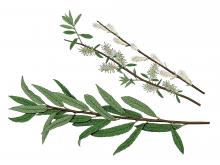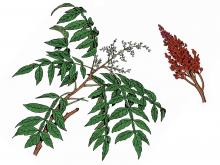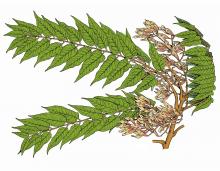Trees, Shrubs and Woody Vines
Media

Species Types
Scientific Name
Salix petiolaris
Description
A clumped shrub that grows naturally only in the northeastern part of Missouri, meadow willow lives in low, wet ground in mud or sandy gravel along streams and in wet meadows. Rare in our state, it is perhaps best identified by examining the leaves.
Media

Species Types
Scientific Name
Euonymus atropurpureus
Description
Eastern wahoo is a native shrub or small tree that grows in wooded areas, near streams, and in thickets. In fall, dainty pink or purplish four-lobed fruit capsules dangle from its branches.
Media

Species Types
Scientific Name
Campsis radicans
Description
Each summer, the bright orange and red “trumpets” of this woody vine decorate Missouri’s cliff faces, telephone poles, and anything else strong enough to support it. Hummingbirds zoom to trumpet creeper’s flowers for their nectar.
Media

Species Types
Scientific Name
Parthenocissus quinquefolia
Description
Occasionally confused with poison ivy, Virginia creeper is easily identified by simply noticing that most of its leaflets are in fives, instead of threes. This common native vine is useful in landscaping.
Media

Species Types
Scientific Name
Rhamnus cathartica
Description
You might see common buckthorn for sale at a nursery, but don’t buy it! At least six states have banned this invasive exotic, and the difficult-to-control plant is causing problems here in Missouri, too. Learn how to identify it — and avoid it!
Media

Species Types
Scientific Name
Corylus americana
Description
American hazelnut is a thicket-forming shrub that grows to about 10 feet high. It is prized for its edible nuts, which are covered by a distinctive leafy or papery, jagged-edged bract.
Media

Species Types
Scientific Name
Rhus copallinum
Description
Winged sumac is most common south of the Missouri River. The "wings" in the name refer to the narrow, flattened leafy structures running along the central stems of the compound leaves.
Media

Species Types
Scientific Name
Ailanthus altissima
Description
Tree-of-heaven is a fast-growing exotic that is common in urban areas. It is weedy and aggressive and should not be planted. It has 2-foot-long feather-compound leaves. Twigs smell unpleasant when you break them.
Media

Species Types
Scientific Name
Rhus spp.
Description
Sumacs are shrubs or small trees that often form colonies from their creeping, branched roots. The foliage usually turns brilliant shades of red in early autumn. The clusters of berrylike fruits are red.
Media

Species Types
Scientific Name
Fagus grandifolia
Description
Limited in our state to well-drained, sandy soils in southeast Missouri, American beech is an impressive tree that has provided Americans with wood for a variety of uses, from furniture to toys to fuel to beer barrels!
See Also
About Trees, Shrubs and Woody Vines in Missouri
There are no sharp dividing lines between trees, shrubs, and woody vines, or even between woody and nonwoody plants. “Wood” is a type of tissue made of cellulose and lignin that many plants develop as they mature — whether they are “woody” or not. Trees are woody plants over 13 feet tall with a single trunk. Shrubs are less than 13 feet tall, with multiple stems. Vines require support or else sprawl over the ground.





















